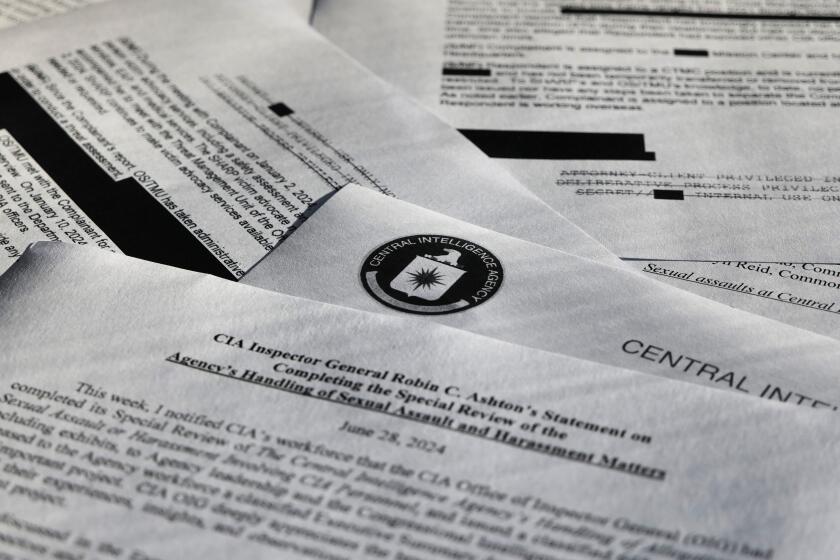High Court Urged to End Race-Based Admissions
WASHINGTON -- The Bush administration Thursday called on the Supreme Court to replace race-based affirmative action in college and university admissions with “race-neutral” approaches that reward top students regardless of their race or ethnic heritage.
Administration lawyers, filing friend-of-the-court briefs in two cases involving undergraduate and law school admissions at the University of Michigan, pointed to policies in Texas, California and Florida that guarantee admission to the top students in all the state’s high schools.
Texas admits the top 10% of students at all of its high schools to its state university system. In California, the top 4% of each high school senior class is guaranteed enrollment at a University of California campus.
But the administration said the high court should condemn university policies that give a special advantage to applicants because of their race or ethnicity.
“The court should hold that the University [of Michigan’s] race- and ethnic-based admissions policies are unconstitutional because proven race-neutral alternatives to achieving the laudable goals of educational openness and diversity remain available,” said U.S. Solicitor General Theodore B. Olson.
The government’s briefs, delivered shortly before the midnight deadline, closely track the approach outlined Wednesday by President Bush.
While the president lauded the value of diversity in higher education, he condemned as “fundamentally flawed” the use of race-based admissions policies as a way to achieve this objective.
“At their core, the Michigan policies amount to a quota system that unfairly rewards or penalizes prospective students based solely on their race,” Bush said in a short statement before television cameras.
The administration’s briefs are advisory only; the justices are free to ignore them.
But the high court is closely split on issues of race, and both sides in the dispute are focusing their arguments on Justice Sandra Day O’Connor, the swing vote between the conservative and liberal factions.
In the past, O’Connor has regularly frowned upon race-based affirmative action plans in such areas as government contracting or broadcasting licenses. However, she has stopped short of joining her more conservative colleagues to forbid any use of race.
By weighing in strongly against race-based policies, the Bush administration puts more pressure on the justices -- or perhaps gives them more encouragement -- to hand down a broad ruling that rejects them.
While Olson’s briefs do not call on the court to overrule the 1978 Bakke decision, which struck down quotas but upheld the use of race as a factor in admissions policies, they go a long way to pushing it aside.
Since “race-neutral alternatives” can always be envisioned, the administration contends, universities would be hard-pressed to defend the explicit use of affirmative action.
“Colleges can attain broad racial diversity [through these] race-neutral admissions policies,” Bush said in his comments Wednesday.
University officials in Texas and California say the “race-neutral” plans touted by Bush stand a better chance of working for undergraduates than for law and medical schools.
In Texas, for example, the law school in Austin has not devised a parallel method for admitting top students from all the state’s colleges, school officials say. Texas adopted its “top 10%” plan after a federal appeals court ruled that the state’s universities could not use race as a factor in admissions.
Bush’s description of the Michigan policies as “a quota system” rankled university officials, who insisted that neither the undergraduate campus at Ann Arbor nor the law school used a quota or a fixed numerical goal for admitting minority students.
At the same time, they acknowledged that they gave extra consideration to applicants who are black, Mexican American or Native American. The university’s policy describes a goal of enrolling “meaningful numbers” or a “critical mass” of minority students.
During the 1990s, the university and the law school had a minority enrollment of from 13% to 20%.
If the court were to strictly ban the use of race in admissions, it would “produce immediate resegregation of many -- and perhaps most -- of the nation’s finest and most selective institutions,” Michigan’s lawyers told the court.
The two cases before the Supreme Court began in 1997, when three white students who were turned down for admission filed lawsuits, contending that the use of “racial preferences” violated the Constitution’s guarantee of equal protection.
In a trial three years ago, a federal judge explored the law school admissions process. Of about 5,000 students who applied, about 1,000 were offered admission.
All those admitted were top students, although the white and Asian candidates had somewhat stronger academic records.
For example, in the class that entered in 2000, white students had a median undergraduate grade-point of average of 3.68, while African American students had a 3.4 grade-point average. This is a scale on which a 4.0 is a straight A average.
U.S. District Judge Bernard Friedman, who tried the case, focused on the systematic difference in favor of the minority applicants during the 1990s, and he struck the law school’s admissions policy as unconstitutional. A federal appeals court in Cincinnati reversed his decision on a 5-4 vote and said the law school was following the “diversity” policy endorsed by the Supreme Court’s Bakke decision.
In early December, the high court voted to hear the pair of Michigan cases to decide whether and under what circumstances colleges and universities can use race as a factor in admissions.
Next month, the university and its allies will file their briefs defending their admissions policy. The justices will hear oral arguments in late March.
More to Read
Sign up for Essential California
The most important California stories and recommendations in your inbox every morning.
You may occasionally receive promotional content from the Los Angeles Times.











